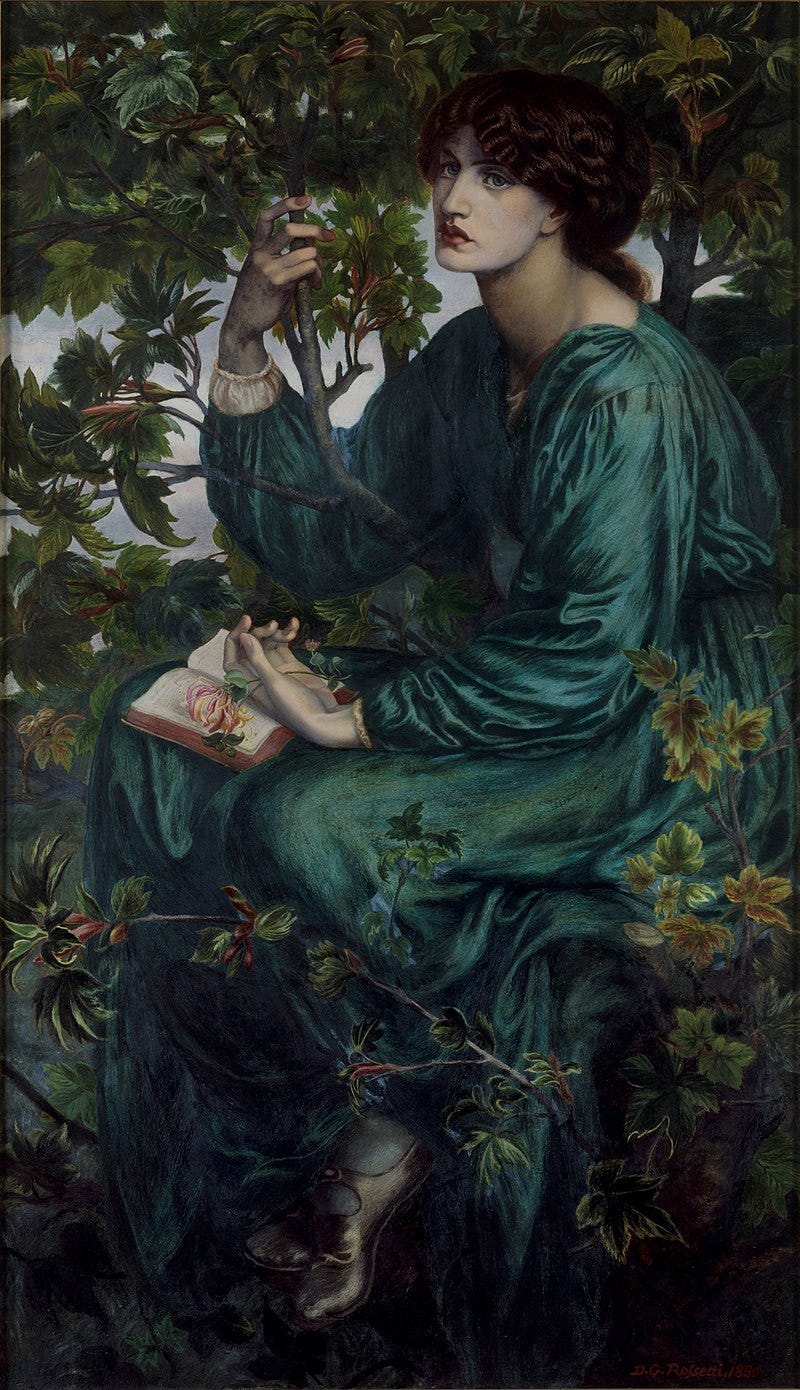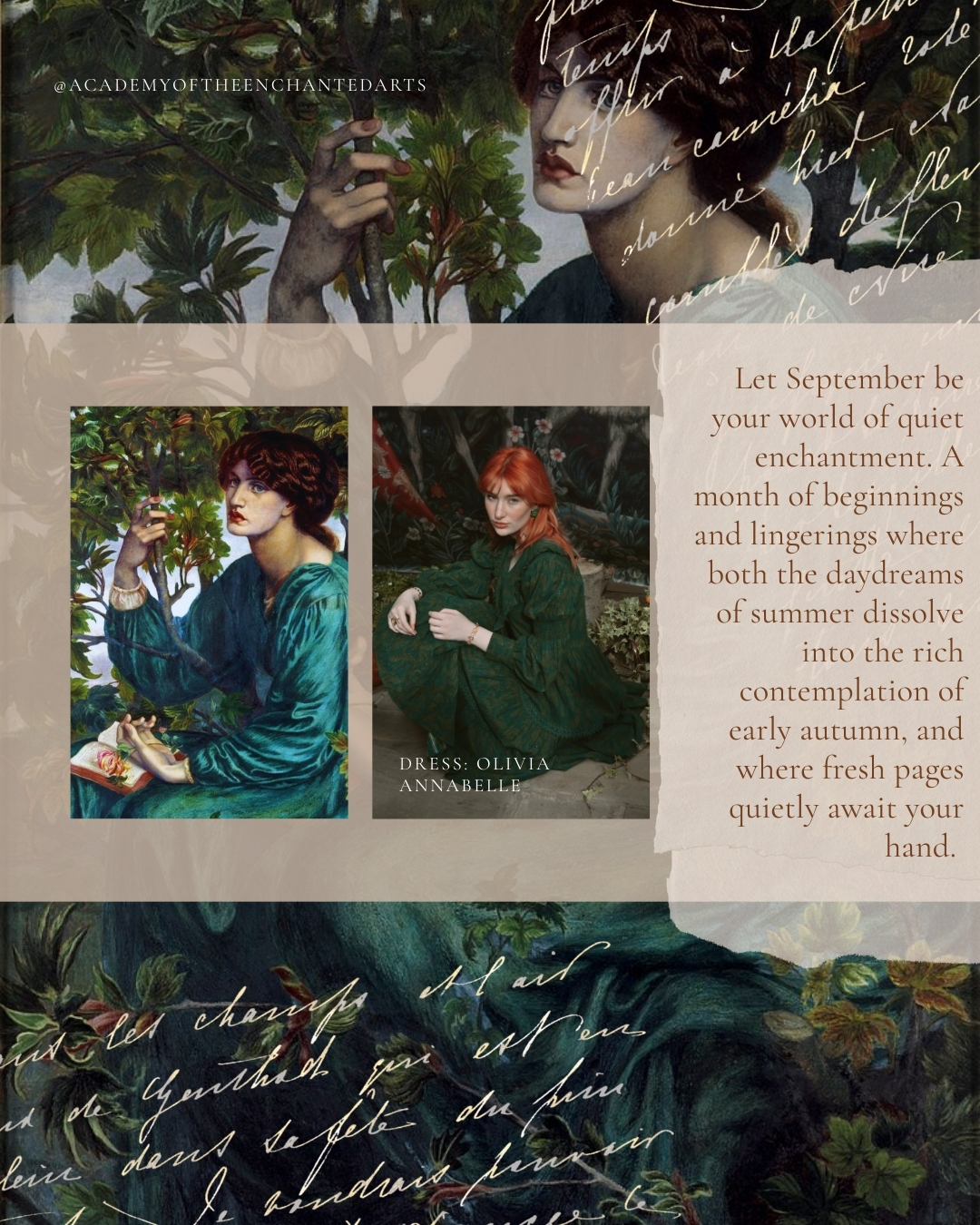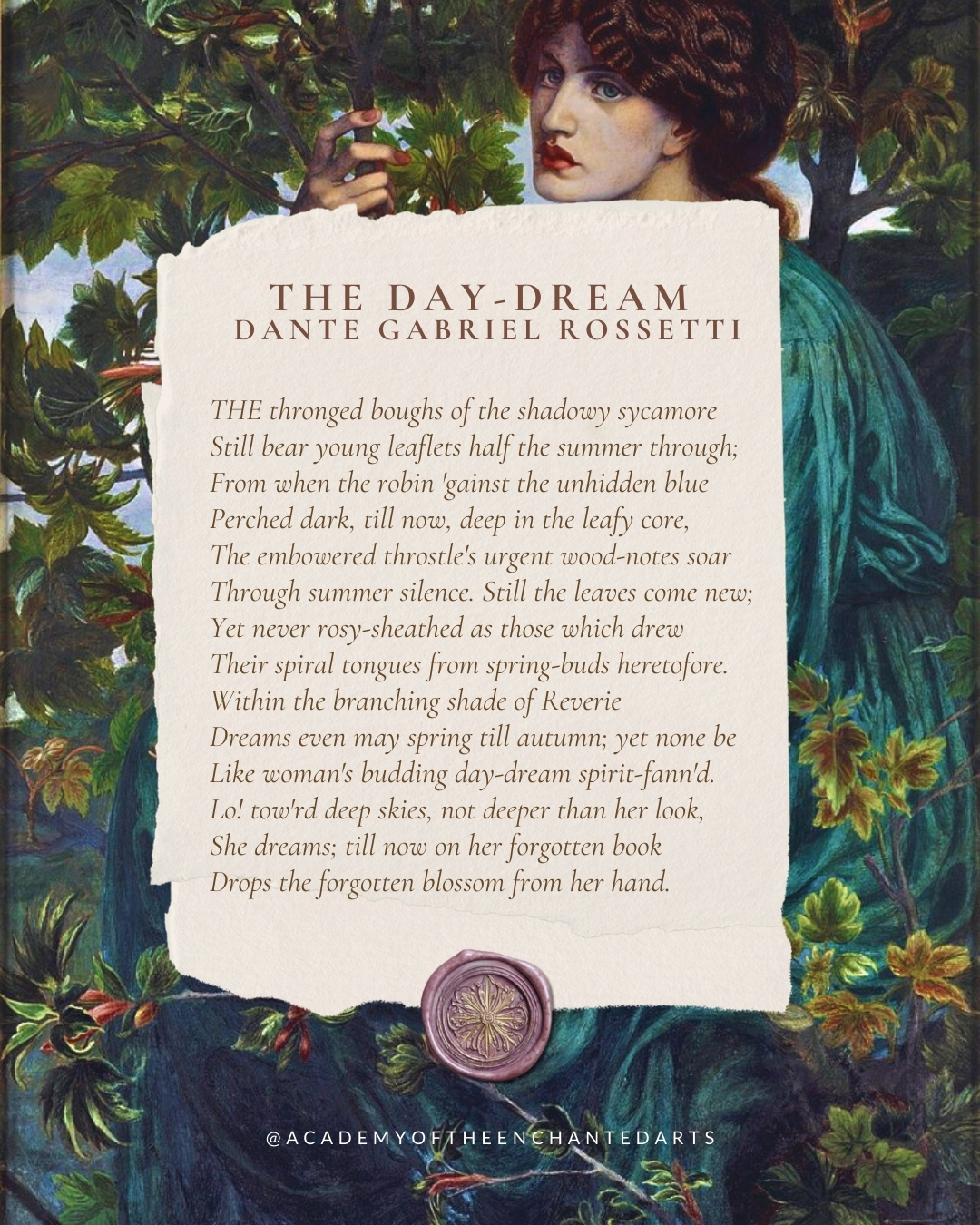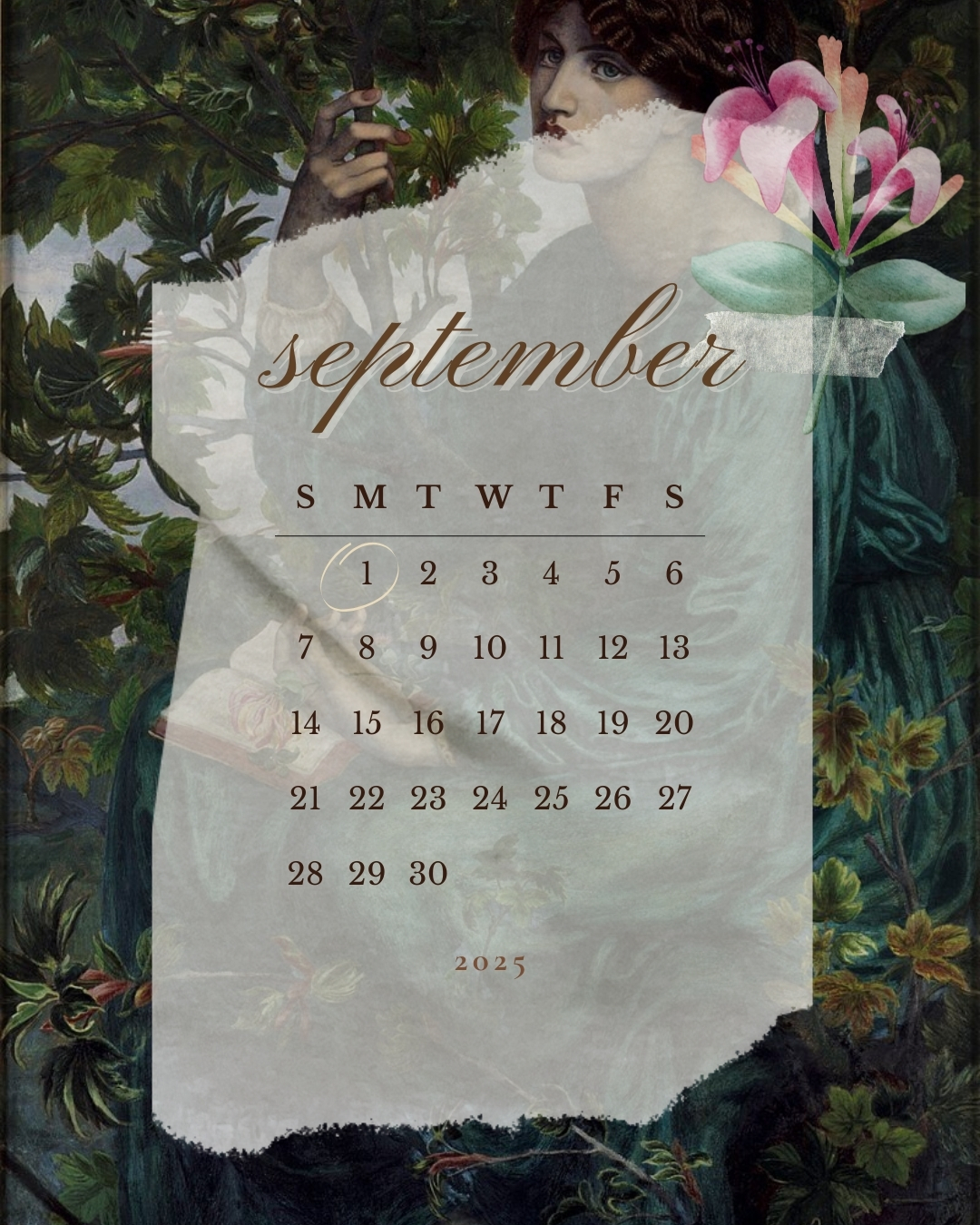The Enchanted Aesthetic: September Syllabus Of Enchantment

The Art of Lingering and September’s Enchanted threshold through Dante Gabriel Rossetti’s The Day Dream'
Dear enchanted one,
In August we drifted through a summer draped in silk with Albert Moore’s The Dreamers, where time itself seemed to dissolve into stillness. It was a month of surrender, of slipping into the suspended breath of high summer, where nothing moved but the slow turning of light upon drapery.
Now September arrives, not as a severing, but as a gentle awakening from that dream. For just a moment, close your eyes for a moment. Feel the warmth of late summer lingering in the shaded green of a golden afternoon. The light filters through the trees in quiet, golden slivers. There is a hush, a suspended breath between what has been and what is yet to come.
This is the world of Dante Gabriel Rossetti’s The Day Dream, our September muse, a painting that is less about narrative and more about the pause of being, the languid elegance of contemplation.
The painting invites us to linger, to savour the tension of moments held, like dew on fallen leaves, and to notice what insists on staying before the inevitable turn of the season. And yet September also carries within it another gift: a fresh start.
For so many, this month rings with the sound of sharpened pencils, opened books, timetables unfolding and the quiet thrill of a new chapter beginning. It is a second January for many, but gentler, swathed in green and gold, with resolutions written not in frost but in mellow light.
Perhaps that is the truest enchantment of The Day Dream: it shows us that beginnings do not have to rush. That study, growth, and transformation can be rooted in stillness, in the soft unfurling of thought beneath a shaded tree. That September is both reverie and renewal and a call to dream and to begin all at once.
And so too does this syllabus invite you, dearest one, into the art of lingering and of becoming. Where August asked us to bask in radiance, September whispers of savouring, but also of stepping forward with quiet intention.
September is a month of holding close to what is slipping away, while at the same time planting the seeds of what is to come. Of walking slowly through the fading light with reverence, yet also feeling the stir of new rhythms quickening within.
By the end of this syllabus, my hope is that you will emerge attuned to this balance: a soul who knows how to cradle sweetness without clutching, who can rest in the in-between with grace, and who can also feel the gentle pulse of beginnings beneath the hush. You will not rush to the ending, nor mourn it too soon, but instead inhabit the pause itself: dream-drowsy, contemplative, yet quietly awake to the tender beauty of what remains, and the promise of what will be.
The Daydream by Dante Gabriel Rossetti

Artwork: The Day Dream (1880) by Dante Gabriel Rossetti
So, first of all, let us drift more deeply into Rossetti’s world. Painted in 1880, The Day Dream is not about endings; it is about savoring the in-between, the suspended moment.
Look closely and we gaze upon our muse Jane Morris who leans against the bough of a sycamore, her figure both relaxed and monumental, her long green gown merging with the leaves until she seems half-rooted, half-apparition. Rossetti paints her not as a woman passing through a garden, but as something elemental but as a presence inseparable from the hush of late summer itself.
In her hand she cradles a spray of honeysuckle. This is no idle choice, for in the Language Of Flowers so beloved by Victorians, honeysuckle speaks of bonds of love, of memory clinging sweetly, of longing that twines and endures. How perfectly this mirrors September as a season that clings to summer’s warmth even as the year leans into decline, where the honeysuckle’s curling tendrils echo the way time itself spirals and lingers, never severing cleanly.
And then, of course, there is Jane Morris herself, Rossetti’s muse, model, and impossible obsession. With her dark, heavy features, long brown hair, and statuesque bearing, she was the Pre-Raphaelite ideal incarnate: a figure at once earthly and otherworldly.
In The Day Dream, she is less woman than archetype, gazing both inward and outward, as though caught between presence and absence, sweetness and sorrow. For Rossetti, she was the embodiment of the unattainable dream; for us, she becomes the emblem of September itself: heavy with thought, luminous with fading light, suffused with beauty that aches precisely because it will not last.
It is striking, isn’t it, to hold this vision alongside Albert Moore’s The Dreamers. In August, Moore’s figures surrendered to languor, reclining as if dissolved into light and drapery, their reverie a hymn to stasis. But here, in September, Jane Morris leans forward. She is upright, contemplative, poised as though listening to something just beyond. Where August was surrender, September is thought; where August basked, September lingers. Both live within the dream, yet the quality of dreaming shifts; from languor to longing, from basking to savouring.
Painted near the end of Rossetti’s life, The Day Dream carries with it a quiet twilight. At this time, Rossetti’s health was failing with his great love affairs and artistic triumphs already shadows in memory. Perhaps this is why the painting feels suspended, almost aching in its stillness, as if Rossetti, like September itself, could not bear to move forward. Instead, he rooted his muse in the tree’s embrace, eternal, contemplative, endlessly dreaming.
The softened greens, the muted earth tones, the filtered light through the leaves, they all conspire to create an atmosphere of reverie. Not the golden brilliance of summer, nor yet the crisp brilliance of autumn, but something hushed, mellow, caught between. To stand before this painting is to feel time hesitate, to sense the fullness of life in a pause.
This, beloved, is why The Day Dream so perfectly embodies our September theme. It is not a month of endings but of savouring, and, not a severing, but a lingering. The honeysuckle reminds us of what clings, the figure of Jane Morris reminds us of beauty’s bittersweetness, the poem reminds us of reverie deeper than sky itself, and Rossetti’s twilight brush reminds us of how fleeting and precious the in-between truly is.
Embodying The Day Dream by Dante Gabriel Rossetti

Let us now start to embody The Day Dream, for, to live as Rossetti's muse is to embrace the art of reverie and to let the world unfold in gentle pauses and thoughtful gazes. Here are invitations to guide your journey:
- Find Your Quiet Corner
Seek a space where time slows. This could be anywhere from a sunlit nook, a garden bench, or a favourite chair by the window. Allow yourself to sit without purpose, letting the surroundings fill you with calm. In this stillness, you become the dreamer, the observer, the muse. - Hold a Flower Close
Like Jane Morris with her honeysuckle, find a flower that speaks to you. Hold it gently in your hands, inhale its fragrance, and let its beauty anchor you in the present moment. This act transforms the ordinary into the extraordinary. - Read with Reverence
Choose a book that invites you into its world. Let the words wash over you without the need to finish quickly. Pause after a sentence that stirs you, reflect on its meaning, and let your thoughts wander. This is reading as an art form, and not a task. - Dress in the Spirit of the Muse
Adorn yourself in garments that echo the painting's aesthetic. For me, there could be nothing more exquisite than the Guinevere Dress by Olivia Annabelle. This dress is a piece that embodies the flowing elegance and timeless beauty of the Pre-Raphaelite muse, Jane Morris. Its soft bamboo fabric and ethereal design invite you to move with grace and contemplation. Become The Day Dreamer even more deeply by pairing it with this sweetest Honeysuckle scent from the Old Apothecary Shop. - Gaze with Intention
Practice the art of looking without expectation. For example, observe the play of light on leaves, the patterns in clouds, the expressions of passersby, or just simply let your gaze linger longer this September, allowing the world to reveal its subtleties to you. - Live the Pause
In moments of transition, between tasks, before meetings, during walks, embrace the pause. Or, as Cal Newport would say ‘feel boredom’, instead of filling it with activity, or scrolling on your phone, rest in it. Let the space between moments become as meaningful as the moments themselves.
Journal Prompts & Reflections
To deepen your reflections from this letter, I invite you to contemplate on these prompts. You are also welcome to pick oracle cards for them too, if you prefer!
- What fleeting sweetness of summer do you wish to hold onto this month?
- Where do your thoughts wander when nothing demands your attention?
- How can you let yourself linger, simply being, before the season turns?
- In which corners of your life might you allow yourself more dreaming, more soft contemplation?
- If you were to write a letter to the last warmth of summer, what would you say, and how would you honour its lingering light?
- What “pauses” could you create for yourself this month, moments to simply watch, breathe, and be?
Reading list for The Day Dream

- The Journal of Dorothy Wordsworth: Step into Dorothy’s gentle observations of the Lake District, her attentiveness to light, water, and the small wonders of the natural world, and let her quiet wonder guide your own days of lingering reflection.
- Short Essays by John Ruskin: On nature, beauty, and art, Ruskin’s essays remind us to slow our gaze and attune to the visual poetry of our world, echoing Rossetti’s tenderly observed detail.
- The Prelude (Selections) by William Wordsworth: Introspective, lyrical, and deeply attuned to nature’s rhythms. His reflections on childhood, memory, and the lakeside landscapes offer a companionable echo to Jane Morris’ contemplative pose.
- To the Lighthouse by Virginia Woolf: A meditation on the soft, passing moments and the rhythm of daily life; a literary embodiment of Jane Morris’ suspended gaze in The Day Dream.
Playlist for The Daydream: Whispers Of The Day Dream: A Rossetti Reverie
Step gently into the world of Dante Gabriel Rossetti’s The Day Dream, where golden sunlight drapes over petals and the soft rustle of leaves becomes a lullaby for the soul.
The Enchanted Lens
Close your eyes, beloved, and feel the golden haze of late summer light spilling across Tuscan hills.
In A Room With A View, this light falls as gently as in The Day Dream, illuminating faces, gardens, and the quiet pauses between conversation.
Lucy Honeychurch’s soft, contemplative glances mirror Jane Morris’s daydreaming gaze, her hesitation and inward reflection echoing the suspended, dream-drowsy elegance of Rossetti’s painting.
The film invites us to savor stillness, to notice the play of light across fabric and foliage, the subtle pulse of longing in a single look. Like our September muse, it asks us to pause, to linger, to see beauty in moments held between breaths. Watch, breathe, and let the quiet poetry of A Room With A View seep into your days, carrying the sweetness of summer and the gentle promise of new beginnings.
September Poem

September, that month of quiet turning, is captured so exquisitely by Dante Gabriel Rossetti, who once wrote in his poem The Day-Dream, “She dreams; till now on her forgotten book / Drops the forgotten blossom from her hand.”
What better image for September, that in-between month of lingering warmth and quiet fading, when time itself seems to dream, half-waking, half-withdrawing?
This poem reminds us that September is a month not only of endings but of reverie. A time to dream with open eyes, to let what fades become beauty in another form, and to gather inspiration from the quiet, hushed abundance of the season.
This ache is crystallised in Rossetti’s own sonnet, written to accompany the painting. He sets Jane beneath the “thronged boughs of the shadowy sycamore,” where summer still lingers, leaf after leaf unfurling though autumn creeps ever nearer.
Moreover, Rossetti imagines Jane not as a passive figure but as the very fountain of reverie and a woman whose dream is so deep that even the blossom she held falls forgotten from her hand. Her inward gaze is more infinite than the sky, and in that gaze Rossetti locates both beauty and melancholy, the timelessness of thought and the inevitability of loss.
In Closing….

September invites us to breathe with intention, to linger in thought, and to savour the textures, scents, and hues of a world suspended between seasons.
Rossetti’s The Day Dream whispers to us across time: notice the subtle, hold space for reverie, and let beauty and contemplation become your companions.
So this September, step slowly, dearest enchanted dreamers, and allow yourself this soft, golden pause.
Let September be your world of quiet enchantment. A month of beginnings and lingerings where both the daydreams of summer dissolve into the rich contemplation of early autumn, and where fresh pages quietly await your hand.
With love and enchantment,
Georgie xoxo

Click here to journey with me to The Lake District
Categories: : The Enchanted Aesthetic
 Georgie
Georgie 